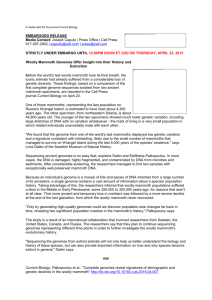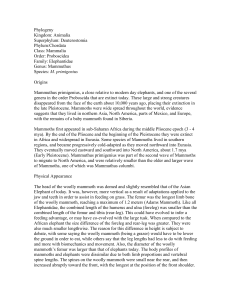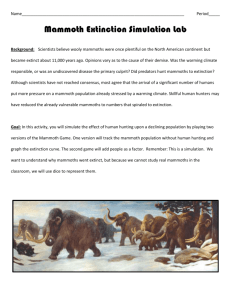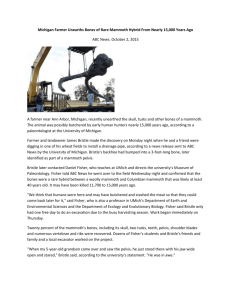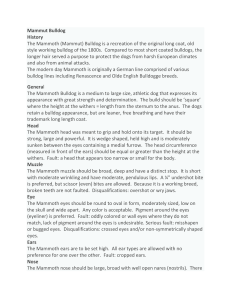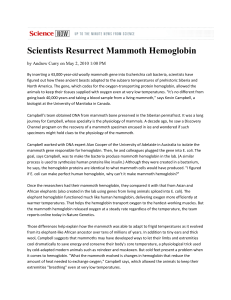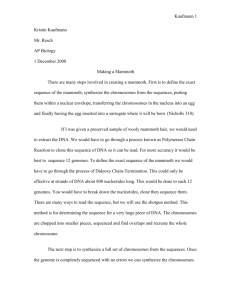santamammoth
advertisement
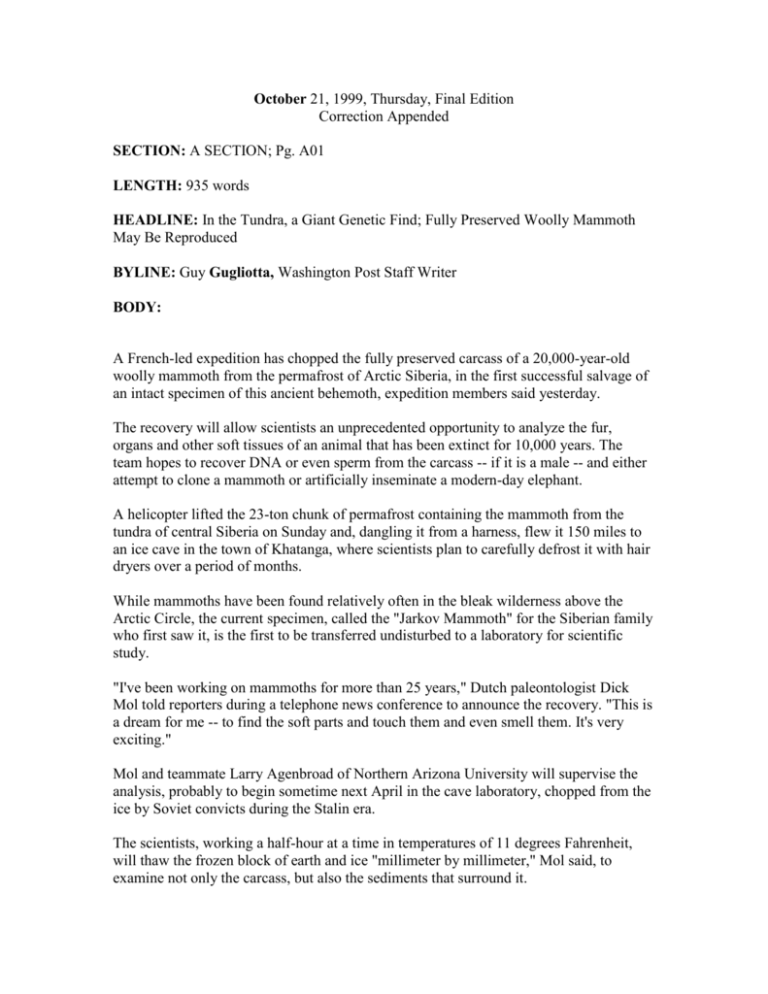
October 21, 1999, Thursday, Final Edition Correction Appended SECTION: A SECTION; Pg. A01 LENGTH: 935 words HEADLINE: In the Tundra, a Giant Genetic Find; Fully Preserved Woolly Mammoth May Be Reproduced BYLINE: Guy Gugliotta, Washington Post Staff Writer BODY: A French-led expedition has chopped the fully preserved carcass of a 20,000-year-old woolly mammoth from the permafrost of Arctic Siberia, in the first successful salvage of an intact specimen of this ancient behemoth, expedition members said yesterday. The recovery will allow scientists an unprecedented opportunity to analyze the fur, organs and other soft tissues of an animal that has been extinct for 10,000 years. The team hopes to recover DNA or even sperm from the carcass -- if it is a male -- and either attempt to clone a mammoth or artificially inseminate a modern-day elephant. A helicopter lifted the 23-ton chunk of permafrost containing the mammoth from the tundra of central Siberia on Sunday and, dangling it from a harness, flew it 150 miles to an ice cave in the town of Khatanga, where scientists plan to carefully defrost it with hair dryers over a period of months. While mammoths have been found relatively often in the bleak wilderness above the Arctic Circle, the current specimen, called the "Jarkov Mammoth" for the Siberian family who first saw it, is the first to be transferred undisturbed to a laboratory for scientific study. "I've been working on mammoths for more than 25 years," Dutch paleontologist Dick Mol told reporters during a telephone news conference to announce the recovery. "This is a dream for me -- to find the soft parts and touch them and even smell them. It's very exciting." Mol and teammate Larry Agenbroad of Northern Arizona University will supervise the analysis, probably to begin sometime next April in the cave laboratory, chopped from the ice by Soviet convicts during the Stalin era. The scientists, working a half-hour at a time in temperatures of 11 degrees Fahrenheit, will thaw the frozen block of earth and ice "millimeter by millimeter," Mol said, to examine not only the carcass, but also the sediments that surround it. Mol noted that the mammoth lay atop clay soil filled with frozen plants that "still had their original green color." And for paleontologists, he continued, "this is very important, because it indicates a lake and pond 20,000 years ago, and might tell us about the climate and temperature at the time." It also might shed light on why the mammoths, whose remains have been found on every continent in the world except Australia and South America, died out despite a lack of natural predators and an ability to function without visible hardship in extreme environments. Agenbroad noted, however, that the new discovery predates species extinction by several millennia. Still, he added, the Jarkov Mammoth was 47 to 49 years old when it died -- the prime of life. "We hope to find viruses in its internal parts," he said. French explorer Bernard Buigues, who led the expedition, said the team would have to spend considerable time thawing and analyzing the mammoth before work could begin to try the unprecedented feat of producing a live animal. Mammoths first appeared in Africa 3 million to 4 million years ago, and are believed to be cousins, rather than ancestors, of modern elephants. But while they have 58 chromosomes and elephants 56, research has shown only a 5 percent genetic difference between the two species. Cross-breeding is theoretically possible. Artificial insemination using frozen semen is standard practice in the livestock industry, but it is unclear whether 10,000-year-old sperm will retain its potency. Cloning remains a very difficult procedure. While scientists have produced genetically identical copies of several species, failures far outnumber successes and no one has ever attempted a crossspecies cloning or the cloning of an extinct creature. If cloning or artificial insemination were attempted with the Jarkov mammoth, it would not happen for three years, with a possible offspring to be born two years after that, Agenbroad said. Buigues, an experienced Arctic explorer, met the Jarkovs in Siberia in 1997 and followed them to a site on the remote Taimyr Peninsula near the Bolchaya-Balakhnya River, where they had found a mammoth while herding reindeer. Mol explained that nomadic Dolgan people had long used mammoth bone to make pieces of harness and other implements. Siberian folklore regards mammoth skeletons as the remains of giant moles who lurked below the Earth's surface. Today, Mol said, the Siberian tundra is the scene of a brisk market in mammoth ivory, especially since trade in elephant tusks has been outlawed in much of the world. In 1998, Buigues brought hair, bone and tissue samples from the Jarkov Mammoth to Utrecht, where Mol dated them at 20,380 years old. Using a ground-penetrating radar, Buigues confirmed that the entombed carcass was an intact woolly mammoth, probably a male, perhaps 11 feet tall and weighing six to eight tons. The Buigues team arrived at the site on Sept. 20 this year -- late enough for the top layer of permafrost to have hardened, but early enough to avoid the worst of the Siberian winter. Past mammoth excavators had thawed the permafrost with fire hoses to free the remains, a procedure that destroyed sites and fatally compromised scientific analysis. The Buigues expedition had a different idea. For two weeks, Dolgan workers used jackhammers to chop a meter-wide trench around the carcass, then quarried a tunnel beneath it, resting the block on a lattice of iron bars to await the helicopter. The expedition was funded by the Discovery Channel, which plans to air a documentary on the project in March. PULLED FROM PERMAFROST (This graphic was not available) CORRECTION-DATE: October 23, 1999 CORRECTION: An article Thursday incorrectly described a woolly mammoth carcass extracted from the Siberian tundra as an "intact specimen." The Discovery Channel, which funded and publicized the expedition, said yesterday the mammoth's head had been removed separately and taken to a laboratory for analysis. GRAPHIC: IG,,TWP LOAD-DATE: October 21, 1999


